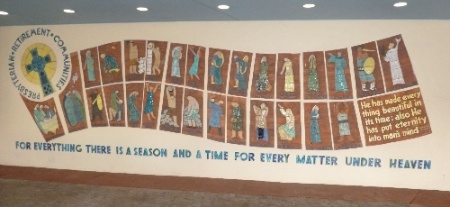The Winter Park Towers Mural
I just returned from a trip to Winter Park, Florida, where I took photographs to document the ceramic mural that Tom and Mary created in 1965 for the front entrance of the Winter Park Towers retirement home in Winter Park, Florida. I would like to thank Tish, the front desk receptionist, Mike Haye, the Executive Director, and the maintenance workers who moved items that blocked a clear view of the mural so that I could photograph it. I arrived at an inconvenient time (around lunch), so I appreciate their gracious help.

I was too young at the time to be privy to all of the details of how the contract for the mural was awarded to Tom and Mary, but I expect that it was finalized sometime in late 1964. Tom was raised as a Methodist and was not too keen on attending church. Mary was raised as a Congregationalist (her father was a deacon in her family’s church in Fort Wayne) and she attended the First Presbyterian Church in Homestead, which she thought was the best match for her religious beliefs. Frank Elvery, the pastor of the church at the time, played an important role in the awarding of the contract, no doubt. The mural was created over a period of months in 1965 and was taken to Winter Park by Tom, where he supervised its installation in September, 1965.
The version of Ecclesiastes 3: 1-8 that Tom and Mary worked from was that of the English Standard Version, which runs like this:
For everything there is a season, and a time for every matter under heaven:
A time to be born, and a time to die;
A time to plant, and a time to pluck up what is planted;
A time to kill, and a time to heal;
A time to break down, and a time to build up;
A time to weep, and a time to laugh;
A time to mourn, and a time to dance;
A time to cast away stones, and a time to gather stones together;
A time to embrace, and a time to refrain from embracing;
A time to seek, and a time to lose;
A time to keep, and a time to cast away;
A time to tear, and a time to sew;
A time to keep silence, and a time to speak;
A time to love, and a time to hate;
A time for war, and a time for peace.
There are 28 panels in the mural and each one depicts a “time” in the verses from Ecclesiastes. In the upper left corner, there is a Celtic cross with the words “Presbyterian Retirement Communities” around the circumference of the circle. At the right lower corner is Ecclesiastes 3:11.
The letters, the Celtic cross and the inscription of Ecclesiastes 3:11 were done by Mary. About half of the individual panels were created by Tom and the other half by Mary. If you study the panels closely, there is a noticeable difference in the execution of the figures in them – some are decidedly “masculine” and done by Tom and others are more “feminine” and were likely done by Mary.
There are close up photographs of the panels in the Gallery (click on the “Galleries” tab above) to study, if you so wish. Unfortunately, I neglected to take a picture of the “A time to be born” panel. That panel was done by Mary. If anyone in Winter Park reads this entry, would they be willing to take a photograph of that panel and send it to me?
What intrigued me upon viewing the mural for the first time is how Tom and Mary were interested, at that early date, in filling areas with fragments of glass, firing the piece to melt the glass and then re-firing the piece with glazes added so that patterns formed in the colored areas. The mural was made out of Hamm’s red clay from Georgia and the tiles are over 1″ thick. This required the addition of grog to the clay so that the pieces wouldn’t crack while being fired. In the Gallery there is a photograph of part of the inscription for one panel – you can see the grog in the clay in that picture. The tiles of the mural were fired to cone 04. The “natural” pieces of each panel appear to have been coated with a red iron wash while the glazed areas are done in mostly muted colors, although the dancer on the “A time to dance” panel has red hair and there is a red sun in the background of the “A time to reap” panel. The letters on each panel are an integral part of the tiles on which they appear – they were not attached separately.
If you look at the inscription at the bottom of the mural, you will note that some letters are blue-green, while the majority are cobalt blue. The blue-green letters were made in 1989 by Mary to replace letters that had been broken over time. My guess is that she did not have a broken letter to work from and thus did her best to match the colors based on a photograph.
I’m glad that I went to see the mural – I had never seen it before in person. I hope that this post will serve to educate those who view the mural about the artists who created it.

Those tiles are beautiful! I love the colors. That is wonderful you are documenting it.
I have some ceramic pieces from Mary ‘n’ Tom from the mid-70s. We would drive down to Homestead and visit them. It was my mom, Pat, Ceil and I. Then we’d go to the Amish strawberry farm, pick strawberries, buy bread and have a shake. Such fond ‘n’ precious memories.